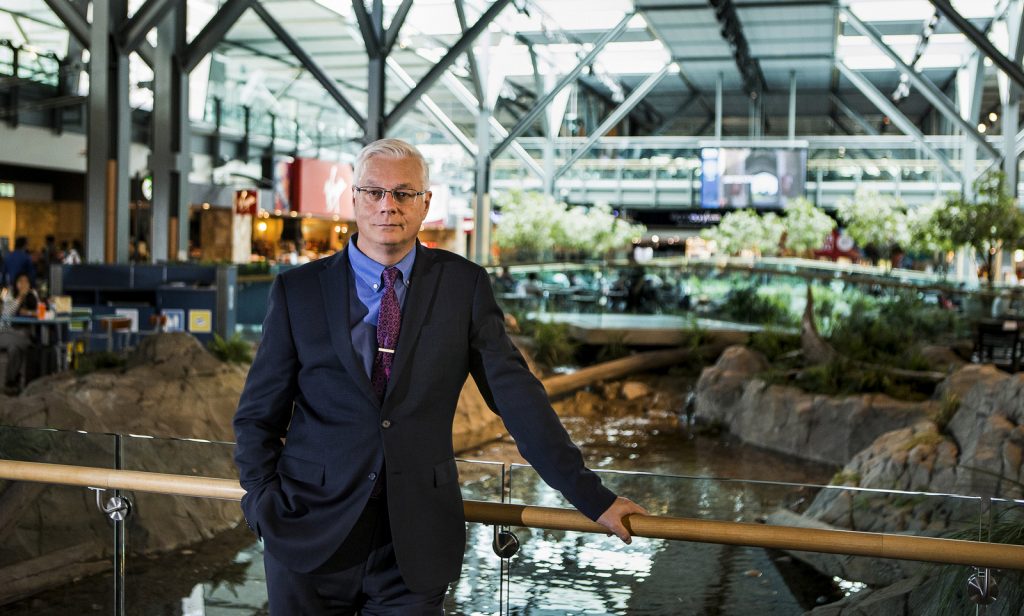Written for Airwaysmag.com
Craig Richmond is the President & Chief Executive Officer of the Vancouver Airport Authority (YVR). Previously, Craig held positions with Vantage Airport Group as CEO of six different airports in thress different countries. From 1995-2006, Craig worked in a variety of operational roles for the Airport Authority including Vice President, Operations.
Craig carved out 15 minutes to speak with Airways about the successes and challenges facing Canada’s Asia-Pacific gateway airport. Richmond has had a long career in airport management worldwide, and re-joined multi-year SkyTrax award-winning YVR in 2013.
Airways – Congratulations on receiving the first Airport Council International-North America’s Excellence in Visionary Leadership Award. What does it mean to you?
It means that I have a very sneaky marketing team who put this whole thing together and sent it off without my knowledge (laughs). It’s an honor, and I’m really proud as a Canadian to be the first recipient. You can afford to look out into the future when you have a great team and you’re not worried about today.
Speaking of the future, we see that YVR has started a master plan, YVR 2037. Can you tell us about it?
It’s mandated by the government that every ten years, we should look out 20 years. So this is actually our third master plan. It’s interesting and kind of serendipitous that our master plan – that we have to do anyway – is occurring in this period of rapid growth. We’re going to pass 21.5 million passengers this year, and we just passed 20 million last year. So we are staring at the 25 million passenger capacity of the terminal.
You’ve already had several public forums about YVR 2037. What kind of feedback have you received?
It’s been really, really good – exceptional. People are giving comments on what kind of amenities they want to see at the airport, ideas for how to make the customer service experience better, all within the context of the technical work that we’ve done to decide how to expand the terminals. They want us to continue with the look and feel and sense of place, and bring as much nature as possible into the terminal and into the experience. Keep up the First Nations art, keep up the idea that it’s not just an efficient airport, it’s actually a nice experience.
What kind of changes and improvements might passengers and airlines see at YVR?
We’re working on expansion plans for our terminals. The first will be International, to add to the terminal to the west. Next will be US Trans-border. And we’re looking at a north-south taxiway to connect the east end of both runways.
It could be billed as the taxiway that’s built for greenhouse gas emission reductions. It’ll reduce the time it takes for US-bound aircraft to the south runway. From one of the deepest trans-border US gates to the south runway is 4.1 km and that gets reduced to just over 1 km. I’m guessing that it’ll be five years or so before we start building it.
You’ve talked about the YVR’s rapid growth over the past few years. Is there any one market that’s driving the increased passenger numbers?
It’s coming from all over, honestly! The domestic [Canadian] market is up hugely, trans-border is up, and Europe, especially in the summer, was tremendous – the load factors on the European flights were just ridiculously full. The British Airways A380 was full every day. And we have a 15% growth to Asia. So it’s not one sector, it’s all of them, and about half our growth is from Air Canada alone.
YVR recently welcomed Xiamen Air, and Beijing Capital Airlines will begin service at the end of the year. How has YVR attracted these new Chinese services?
There are many factors. It’s been our strategy for 24 years, so it’s finally bearing fruit. YVR has the most mainland Chinese carriers of any airport in North America, South America and Europe. And we’re talking to a couple of others – watch this space!
YVR is very close geographically to Seattle’s Sea-Tac Airport. How would you characterize the relationship between YVR and SEA?
We compete, but its friendly competition, and we have a great relationship with them. They’ve got twice as many passengers as we do, and it’s almost all US domestic. They’re breaking out into the international routes, but we’re way ahead of them. We’re very like-minded in how we’re stewards of the environment, and we keep our rivalry between the marketing teams. There’s a lot of goodwill between us.
YVR is yet to see service from the ME3 – Emirates, Etihad, and Qatar. Yet Emirates flies two Boeing 777s a day on the SEA-Dubai route. Would you welcome them to YVR?
Yes. It’s a question of fairness. Montreal and Toronto both have carriers that go to the UAE countries. We don’t. In fact, we’re alone amongst the major airports in North America. It’s unfair for our passengers, because 18,000 people a year go from here to those two flights [at SEA]. So how is that good for us?
I don’t want to have so many flights from these carriers so that it distorts the market. We’re not looking for that. Three a week would be great. But I don’t see that changing anytime soon, as Air Canada is not in support of increased capacity from the ME3. I can understand their position, but I just think it’s a bit weird for us to be left out. I don’t see how it’s good for Vancouver and Canada that so many people head down to Seattle.
Thanks for taking the time to chat, Craig.
My pleasure, and I’m off to my next meeting!
